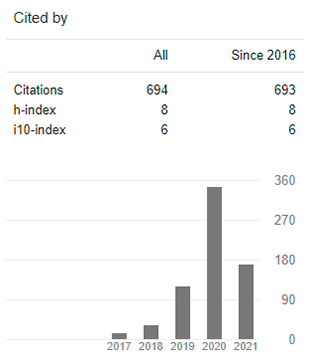Productive Patios as a Strategy for the Consolidation of Environmental Education
DOI:
https://doi.org/10.29394/Scientific.issn.2542-2987.2018.3.10.2.40-60Keywords:
food security, environmental education, environmentAbstract
The study focused on the general objective of proposing productive playgrounds as a strategy for the consolidation of environmental education in the teachers of the "Francisco Rivas" Basic School, located in the Barinas municipality, Barinas state. The research was framed in the quantitative approach, inserted in the Feasible Project modality and supported by a descriptive field study. The population and sample consisted of sixty-five (65) educators from the aforementioned institution. From there, all of it was taken into consideration for the sample. As for the collection of the information, a Likert-type questionnaire with five (05) alternative answers was used: Always, Almost Always, Sometimes, Almost Never and Never. Therefore, it was validated by judges or experts applying Cronbach's internal consistency coefficient (alpha). The study concludes: Teaching professionals need the use of sustainable development in the consolidation of environmental education; as well as teachers lack the use of endogenous development in the promotion of productive playgrounds as a strategy in the institution. Also, they have no use of environmental values to promote the productive courtyards in the institution and community. Educators infrequently maintain a positive attitude towards the consolidation of productive playgrounds at school.
Downloads
References
Cárdenas, B. (2015). Importancia de los Patios Productivos. Colombia: Trillas.
Comunidad Andina (2010). Estrategias, Políticas y Acciones de Seguridad Alimentaria para Poblaciones Indígenas en los Países de la Comunidad Andina. Perú: Congreso de la República. Recuperado de: http://www2.congreso.gob.pe
Díaz, C. (2013). Patios Productivos. Colombia: Norma.
García, C., & Rosales, V. (2012). Problemas Ambientales a Nivel Mundial. Buenos Aires, Argentina: Ares.
González, R. (2012). Problemas Ambientales en Venezuela. Caracas, Venezuela: Editores.
Jácome, R., & Falcones, A. (2012). Medición de la Seguridad Alimentaria y Nutricional en Familias con Niños/As Menores de 5 Años de la Comunidad el Cerotal, Cantón Antonio Ante, Provincia de Imbabura. Ecuador: Universidad Técnica del Norte. Recuperado de: http://repositorio.utn.edu.ec/handle/123456789/2159
Mendoza, Y. (2017). Fortalecimiento de la Educación Ambiental a Través de la Siembra de Plantas Ornamentales. Revista Scientific, 3(7), 309-328. Recuperado de: https://doi.org/10.29394/Scientific.issn.2542-2987.2018.3.7.16.309-328
Monje, C. (2011). Metodología de la Investigación Cuantitativa y Cualitativa. Guía Didáctica. Colombia: Universidad Surcolombiana. Recuperado de: https://www.uv.mx/rmipe/files/2017/02/Guia-didactica-metodologia-de-la-investigacion.pdf
PNSAN (2012). Plan Nacional de Seguridad Alimentaria y Nutricional (PNSAN) 2012-2019. Colombia: Comisión Intersectorial de Seguridad Alimentaria y Nutricional. Gobierno Nacional de Colombia. Recuperado de: http://www.osancolombia.gov.co/doc/pnsan.pdf
Pulido, J. (2015). Propósitos de los Patios Productivos. Colombia: Norma.
Rangel, M. (2012). Metodología de la Investigación. Barinas, Venezuela: Ediciones de la Universidad Nacional Experimental de los Llanos Occidentales “Ezequiel Zamora”.
Requena, Y. (2018). Investigación Acción Participativa y Educación Ambiental. Revista Scientific, 3(7), 289-308. Recuperado de: https://doi.org/10.29394/Scientific.issn.2542-2987.2018.3.7.15.289-308
Villafañe, M. (2013). Metodología de la Investigación. Venezuela: Trillas.
Zarraga, L. (2014a,b). Lineamientos de Supervisión para la Implementación del Programa “Todas las Manos a la Siembra” en Educación Media General. Trabajo de Grado de Maestría. Maracaibo, Venezuela: Universidad Rafael Urdaneta. Recuperado de: http://200.35.84.131/portal/bases/marc/texto/9217-14-08699.pdf
Published
How to Cite
Issue
Section
License
Copyright (c) 2018 INDTEC, C.A.

This work is licensed under a Creative Commons Attribution-NonCommercial-ShareAlike 4.0 International License.
The content of the journals of this site, are under a Creative Commons Attribution-Noncommercial-Share Alike 4.0 International License.













